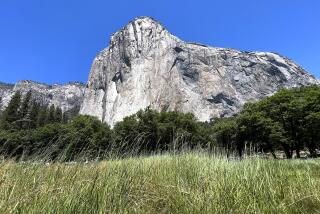Popular U.S. Web Sites Remain Shut
- Share via
The abrupt shutdown of Internet Web sites run by the U.S. Department of the Interior four weeks ago has left Americans in the dark about activities on millions of acres of federal lands, national parks and monuments.
Public access has been barred to government Web sites that once allowed people to plan camping trips in Yosemite National Park, do research on endangered wildlife, track controversial gas drilling in the Rocky Mountains or even use online links to purchase tickets to Alcatraz or check the visiting hours at New York’s Ellis Island.
The shutdown stems from a long-running case involving alleged mismanagement of money held in trust for Indian tribes. The presiding judge ordered the closure of Interior Department Web sites, which he found to be vulnerable to hacking.
Now, tourists seeking the popular National Park Service Web site, which typically gets 700,000 hits a day, are greeted with an apologetic note that operations are suspended “due to conditions outside our department.” High school students writing papers about America’s most endangered wildlife aren’t able to view the U.S. Fish and Wildlife site, which is full of colorful photos and statistics about imperiled birds, foxes and butterflies.
The shutdown is a dramatic illustration of how dependent the public has become on government Web sites for everything from national park road conditions to proposals for mining and oil and gas drilling.
It is provoking growing concern among environmentalists who fear that the loss of the Internet connection is blocking public access to important data about upcoming decisions on land overseen by Interior agencies such as the Park Service and the U.S. Bureau of Land Management.
“There’s a fairness issue at stake,” said Susan Daggett, managing attorney with the Denver office of Earthjustice, a public interest law firm.
In Wyoming, the Bureau of Land Management plans to issue a massive draft environmental review Jan. 11, scrutinizing 50,000 proposed oil and gas wells in the Powder River Basin, a sage-specked prairie sliced by deep canyons that is home to pronghorn antelope, mule deer and other wildlife. The study is the largest ever conducted in Wyoming of coal-bed methane extraction, a much-contested process that can displace and pollute enormous quantities of water.
Unless the BLM Web site is reopened soon, interested citizens will have to call and request paper copies of the review document. And while many environmental groups are on the agency’s mailing lists, many private citizens are not, said Tom Darrin, staff attorney at the Wyoming Outdoor Council, a nonprofit environmental group.
BLM Wyoming spokesman Beverly Gorny countered that her agency is working hard to notify the public of important deadlines and reviews, issuing media releases and contacting interested parties.
At the same time, some energy companies worry that their requests for drilling permits may get lost in the shuffle at the bureau, which often charts such applications electronically.
“When some of our companies are calling [BLM] to ask where their permit is in the process, they can’t be told,” said Bob Gallagher, president of the New Mexico Oil and Gas Assn. “It is absolutely hurting our ability to produce oil and gas.”
The closure of the Interior Department’s Web sites has garnered little attention, especially after the Sept. 11 terrorist attacks prompted the closing or editing of many federal government sites to keep sensitive information secure.
The Department of the Interior shutdown, however, is not an anti-terrorist move. It grows out of an ongoing lawsuit claiming that the federal government is mishandling Indian trust fund accounts overseen by the department.
U.S. District Court Judge Royce C. Lambeth on Dec. 5 ordered the department to “immediately disconnect from the Internet all information technology systems that house or provide access to Indian trust data” as well as “all computers within the custody and control of the Department of the Interior, its employees and contractors, that have access to individual Indian trust data.”
The department has since been able to activate the site of the U.S. Geological Survey, which carries weather and earthquake information, as well as part of a national fire center site. But officials cannot say how soon all sites will be running again.
“We’re working as fast as we can. All of us are,” said Eric Ruff, the Interior Department’s director of communications. The department has hired an outside contractor to scrutinize the security of the sites. Special “firewalls” and intrusion detectors may be added, he said.
Among the complaints received by agency officials were those from two Toronto college students bewildered when they could not read government reports required for their final exam. The students telephoned National Park Service spokesman David Barna asking him to call their professor and confirm that the material was unavailable. Barna complied.
Security experts said the department’s security problems are probably not being overblown.
“It should come as no surprise,” said Bruce Schneier, founder of Counterpane Internet Security, based in Sunnyvale, Calif.
For Interior employees, the order has turned the clock back five years or more. Time cards are being processed on paper. Thick environmental reviews must be faxed.
Even employees’ Internet access has been halted, leaving them unable to view other agencies’ sites, use a search engine or send e-mail to colleagues in other agencies.
More to Read
Sign up for Essential California
The most important California stories and recommendations in your inbox every morning.
You may occasionally receive promotional content from the Los Angeles Times.










